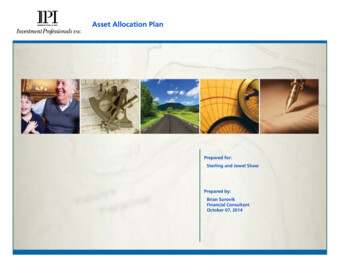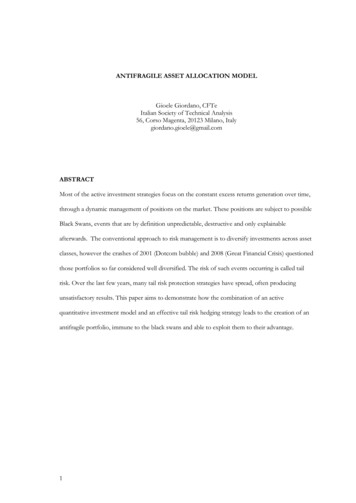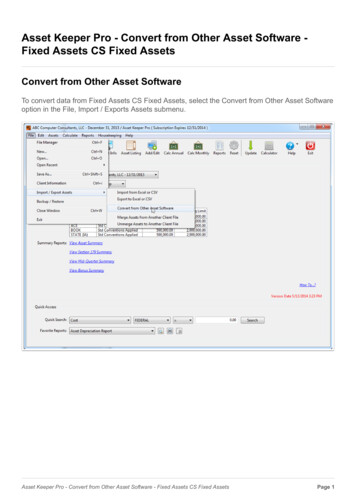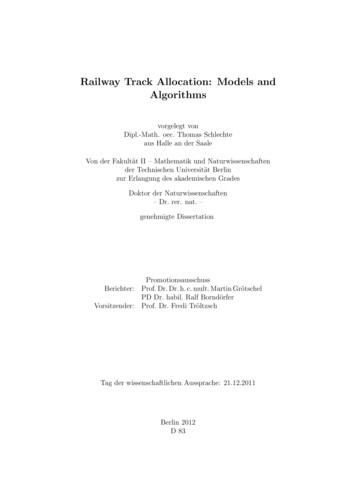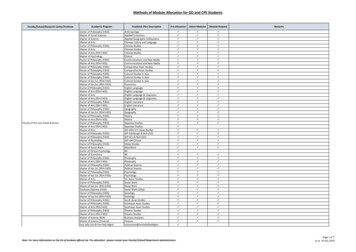
Transcription
Strategic Asset Allocation and CommoditiesCommissioned byPIMCOMarch 27, 2006225 North Michigan Avenue Suite 700 Chicago, IL 60601-7676 y (312) 616-1620sdsaStudy Prepared by:Thomas M. Idzorek, CFADirector of Research 2006 Ibbotson AssociatesStrategic Asset Allocation and CommoditiesIssued & Approved by PIMCO Europe Ltd.For Qualified Investors OnlyFor Educational Purposes Only
Correspondence should be sent to:Ibbotson Associates225 North Michigan AvenueSuite 700Chicago, IL 60601-7676Phone: 312 616 1620Fax: 312 616 0404About Ibbotson AssociatesIbbotson Associates opened its doors in 1977 to bridge the gap between modern financial theoryand real-world investment practice. Professor Roger G. Ibbotson, the company founder andChairman, pioneered collecting the requisite data used in asset allocation and in quantifying thebenefits of diversification. The firm continues to provide solutions to investment and financeproblems for a diverse set of markets. Ibbotson Associates fills a growing need in the financeindustry as a single-source provider of investment knowledge, expertise, and technology.Ibbotson Associates’ investment management services include asset allocation design, backtesting of portfolio strategies, mutual fund analysis, assessment of investor risk tolerance,employee training, structuring and education for retirement plans, and client-specific research.Ibbotson Associates’ products include client presentation materials, computer-based training, andasset allocation software tools. 2006 Ibbotson Associates, Inc. Used with permission. All Rights Reserved 2006 Ibbotson AssociatesStrategic Asset Allocation and CommoditiesIssued & Approved by PIMCO Europe Ltd.For Qualified Investors OnlyFor Educational Purposes Only
Table of ContentsExecutive Summary . iiiIntroduction. 1Section 1: Strategic asset allocation and the opportunity set. 3Exposure to Commodities. 5Commodity Indices. 10Asset Class Proxies for the Opportunity Set. 13Historical Return and Risk. 14Commodity Correlations with the Other Asset Classes. 16Section 2: Historical Efficient Frontiers with and without Commodities . 21Section 3: Forward-Looking Efficient Frontiers with and without Commodities . 24The Commodity Return Puzzle. 24Greer’s Commodity Futures Pricing Model . 25Extending the Capital Asset Pricing Model to Commodities Futures . 29A Building Blocks Approach to Estimating Returns. 37The Black-Litterman Model: Combining the CAPM with Building Blocks. 41A Sensitivity Analysis with Low Expected Commodity Returns. 45Surplus Optimization and Future Research . 47Conclusion . 47References. 49 2006 Ibbotson AssociatesStrategic Asset Allocation and CommoditiesIssued & Approved by PIMCO Europe Ltd.For Qualified Investors OnlyPage iFor Educational Purposes Only
Tables and FiguresFigure 1: Risk-Return (January 1997 – March 2004).7Figure 2: Risk-Return (January 1991 – March 2004).8Table 1: Historical Returns of Commodity, U.S. Stock, and U.S. Bond Indices .9Table 2: Commodity Index Constituents and Weights .12Table 3: Composite Commodity Index Weights .13Table 4: Asset Classes and Asset Class Proxies .14Figure 3: Growth of 1 Investment, January 1970 – October 2005 .15Table 5: Historical Returns and Standard Deviations.16Table 6: Arithmetic Historical Returns for Eight Years of Negative U.S. Stock Returns.16Table 7: Arithmetic Historical Returns for Seven Years of Negative Returns for 50% U.S. Stock50% U.S. Bond Portfolio .17Table 8: Arithmetic Historical Returns for Two Years of Negative U.S. Bond Returns .17Table 9: Correlation Coefficients of Annual Total Returns, 1970–2004.18Figure 4: Rolling Ten-Year Correlations of Commodities with other Asset Classes.19Figure 5: Historical Efficient Frontier with and without the Commodities Asset Class.21Figure 6: Historical Efficient Frontier Area Graph with Commodities .23Figure 7: Historical Efficient Frontier Area Graph without Commodities .23Figure 8: Roll Returns.26Figure 9: Evans-Archer Diversification.28Table 10: Market Capitalization Estimates.31Figure 10: Implied Beta of Commodities .32Table 11: Market Capitalization Estimates.33Figure 11: Forward-Looking Efficient Frontier with and without the Commodities Asset Classbased on CAPM Expected Return .34Figure 12: Forward-Looking (CAPM) Efficient Frontier Area Graph with Commodities .35Figure 13: Forward-Looking (CAPM) Efficient Frontier Area Graph without Commodities .35Table 12: Asset Allocations and Summary Statistics .36Figure 14: Historical Return Decomposition.37Table 13: Commodity Returns.38Table 14: Building Block Return Estimates .38Figure 15: Forward-Looking Efficient Frontier with and without the Commodities Asset Classbased on Building Block Expected Return .39Figure 16: Forward-Looking (Building Block) Efficient Frontier Area Graph with Commodities .40Figure 17: Forward-Looking (Building Block) Efficient Frontier Area Graph withoutCommodities .40Table 15: Asset Allocations and Summary Statistics .41Table 16: Black-Litterman Combined Return Estimates.42Figure 18: Forward-Looking Efficient Frontier with and without the Commodities Asset Class .42Figure 19: Forward-Looking (Combined) Efficient Frontier Area Graph with Commodities .43Figure 20: Forward-Looking (Combined) Efficient Frontier Area Graph without Commodities .43Table 17: Asset Allocations and Summary Statistics .44Table 18: Reduced Return Forecasts for Commodities .45Figure 21: Sensitivity Analysis – Asset Allocation Comparison.46 2006 Ibbotson AssociatesStrategic Asset Allocation and CommoditiesIssued & Approved by PIMCO Europe Ltd.For Qualified Investors OnlyPage iiFor Educational Purposes Only
Executive SummaryThis paper studies the role of commodities in a strategic asset allocation. Commodities are realreturn, real assets that are part of the consumable/transformable super asset class and the storeof-value super asset class. There are several methods of obtaining exposure to commodities. Thispaper focuses on the type of exposure to commodities produced by a fully collateralized totalreturn commodity index. To study the historical return characteristics of commodities, weformed an equally weighted, monthly rebalanced composite of four commodity indices. Ourhistorical analysis supports the claims that commodities have low correlations to traditionalstocks and bonds, produce high returns, hedge against inflation, and provide diversificationthrough superior returns when they are needed most.Using historical capital market assumptions based on annual data from 1970 to 2004, we foundthat including commodities in the opportunity set resulted in a superior historical efficientfrontier, which included large allocations to commodities. Over the common standard deviationrange, the average improvement in historical return at each of the risk levels was approximately133 basis points.The various elements of Greer’s commodity pricing model are the likely return drivers ofcommodities. Commodity returns come from collateral and a commodity strategy premium. Aninsurance premium, a convenience yield, and a diversification/rebalance return all contribute tothe commodity strategy premium. We believe commodities offer an inherent or natural returnthat is not conditional on skill.We developed an expanded working version of the hypothetical market portfolio that includescommodities. Doing so enabled us to create a set of expected returns based on the CAPM, amodel that most practitioners believe does not apply to commodities. Under what can only becharacterized as a very conservative commodity expected return estimate relative to historicalcommodity returns, we created forward-looking efficient frontiers with and without commoditiesincluded in the opportunity set. Using CAPM expected returns, the inclusion of commodities inthe opportunity set improved the efficient frontier. Over the common standard deviation range ofapproximately 2.4% to 22.4%, the average improvement in return at each of the risk levels wasapproximately 35 basis points. Allocations to commodities ranged from 0% to nearly 25%.Using expected returns based on the building blocks methodology led to similar results. Theseresults were independent of market capitalization estimates. Over the common standard deviationrange of approximately 2.4% to 17.2%, the average improvement in return at each of the risklevels was approximately 77 basis points. Allocations to commodities ranged from 0% to 31%.In our third analysis, using the Black-Litterman model, CAPM expected returns were combinedwith expected returns based on the building blocks methodology. Once again, includingcommodities in the opportunity set led to an efficient frontier above an efficient frontier in whichcommodities were excluded from the opportunity set. Over the common standard deviation rangeof approximately 2.4% to 22.4%, the average improvement in return at each of the risk levelswas approximately 36 basis points. Allocations to commodities ranged from 0% to nearly 28%. 2006 Ibbotson AssociatesStrategic Asset Allocation and CommoditiesIssued & Approved by PIMCO Europe Ltd.For Qualified Investors OnlyPage iiiFor Educational Purposes Only
In a sensitivity analysis, the three forward-looking optimizations were repeated under theassumption that the expected return on commodities will be 2% above the expected return ofcollateral. Despite the dramatic reductions in the expected returns of commodities, commoditiescontinued to play a significant role in the forward-looking strategic asset allocations.No matter which set of returns was used, including commodities in the opportunity set improvedthe risk-return characteristics of the efficient frontier. Furthermore, commodities played animportant and significant role in the strategic asset allocations. Given the inherent return ofcommodities, there seems to be little risk that commodities will dramatically underperform theother asset classes on a risk-adjusted basis over any reasonably long time period. If anything, therisk is that commodities will continue to produce equity-like returns, in which case, the forwardlooking strategic allocations to commodities are too low. 2006 Ibbotson AssociatesStrategic Asset Allocation and Commoditie
phenomenon. This paper studies the role of commodities in a strategic asset allocation. Strategic asset allocation is both a process and a result. It is the process of determining the target long-term allocations to the available asset classes. It is widely agreed upon that the strategic asset allocation is the most important decision in the investment process, and for diversifiedFile Size: 1MBPage Count: 63People also search formanaged futures funds commodieyasset allocation models examplesibbotson commodity pimco pdfinvestment asset allocationasset allocation models



